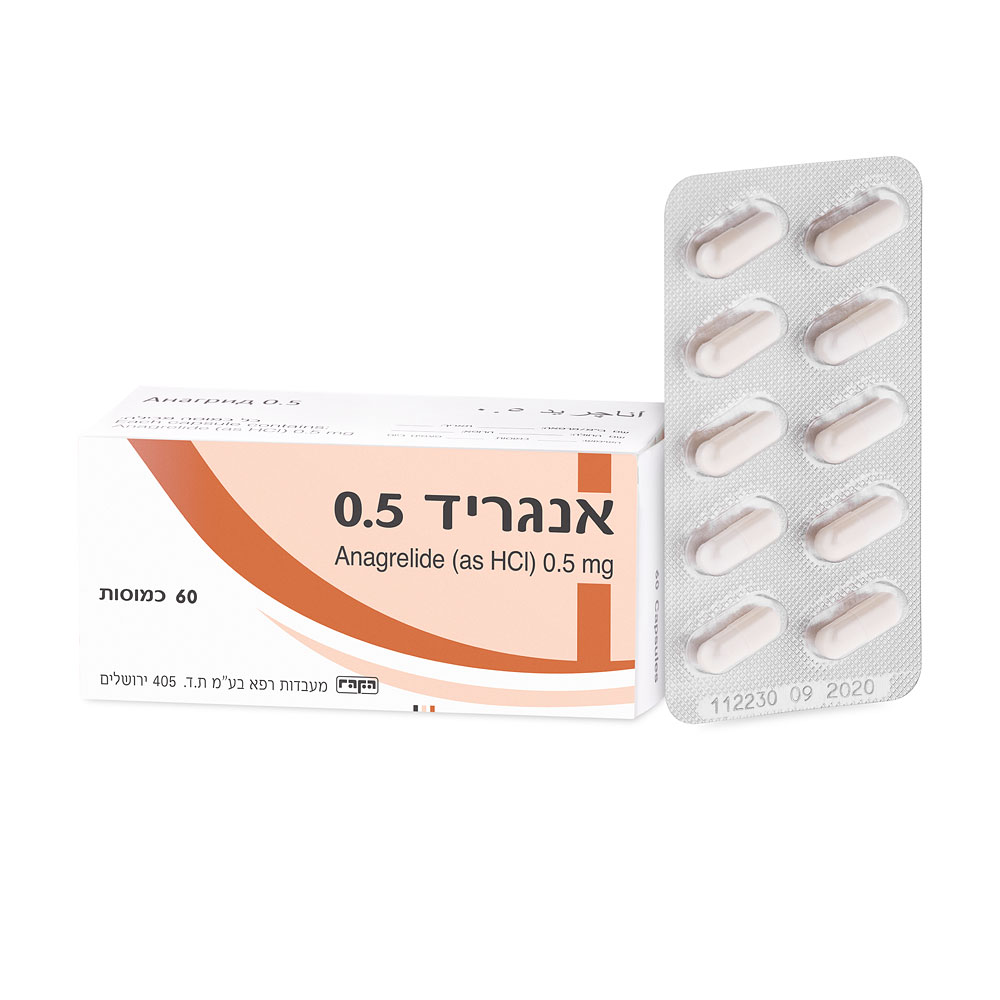Quest for the right Drug

אנגריד 0.5 ANAGRID 0.5 (ANAGRELIDE AS HYDROCHLORIDE)
תרופה במרשם
תרופה בסל
נרקוטיקה
ציטוטוקסיקה
צורת מתן:
פומי : PER OS
צורת מינון:
קפסולות : CAPSULES
עלון לרופא
מינוניםPosology התוויות
Indications תופעות לוואי
Adverse reactions התוויות נגד
Contraindications אינטראקציות
Interactions מינון יתר
Overdose הריון/הנקה
Pregnancy & Lactation אוכלוסיות מיוחדות
Special populations תכונות פרמקולוגיות
Pharmacological properties מידע רוקחי
Pharmaceutical particulars אזהרת שימוש
Special Warning עלון לרופא
Physicians Leaflet
Special Warning : אזהרת שימוש
4.4 Special warnings and precautions for use Hepatic impairment The potential risks and benefits of anagrelide therapy in a patient with mild impairment of hepatic function should be assessed before treatment is commenced. It is not recommended in patients with elevated transaminases (>5 times the upper limit of normal) (see sections 4.2 and 4.3). Renal impairment The potential risks and benefits of anagrelide therapy in a patient with impairment of renal function should be assessed before treatment is commenced (see sections 4.2 and 4.3). Thrombotic Risk Abrupt treatment discontinuation should be avoided due to the risk of sudden increase in platelet counts, which may lead to potentially fatal thrombotic complications, such as cerebral infarction. Patients should be advised how to recognize early signs and symptoms suggestive of thrombotic complications, such as cerebral infarction, and if symptoms occur to seek medical assistance. Treatment discontinuation In the event of dosage interruption or treatment withdrawal, the rebound in platelet count is variable, but the platelet count will start to increase within 4 days of stopping treatment with anagrelide and will return to pre-treatment levels within 10 to 14 days, possibly rebounding above baseline values. Therefore, platelets should be monitored frequently (see section 4.2). Monitoring Therapy requires close clinical supervision of the patient which will include a full blood count (haemoglobin and white blood cell and platelet counts), assessment of liver function (ALT and AST), renal function (serum creatinine and urea) and electrolytes (potassium, magnesium and calcium). Cardiovascular Serious cardiovascular adverse events including cases of torsade de pointes, ventricular tachycardia, cardiomyopathy, cardiomegaly and congestive heart failure have been reported (see section 4.8). Caution should be taken when using anagrelide in patients with known risk factors for prolongation of the QT interval, such as congenital long QT syndrome, a known history of acquired QTc prolongation, medicinal products that can prolong QTc interval and hypokalaemia. Care should also be taken in populations that may have a higher maximum plasma concentration (Cmax) of anagrelide or its active metabolite, 3-hydroxy anagrelide, e.g., hepatic impairment or use with CYP1A2 inhibitors (see section 4.5). Close monitoring for an effect on the QTc interval is advisable. A pre-treatment cardiovascular examination, including a baseline ECG and echocardiography is recommended for all patients prior to initiating therapy with anagrelide. All patients should be monitored regularly during treatment (e.g., ECG or echocardiography) for evidence of cardiovascular effects that may require further cardiovascular examination and investigation. Hypokalaemia or hypomagnesaemia must be corrected prior to anagrelide administration and should be monitored periodically during therapy. Anagrelide is an inhibitor of cyclic AMP phosphodiesterase III and because of its positive inotropic and chronotropic effects, anagrelide should be used with caution in patients of any age with known or suspected heart disease. Moreover, serious cardiovascular adverse events have also occurred in patients without suspected heart disease and with normal pre-treatment cardiovascular examination. Anagrelide should only be used if the potential benefits of therapy outweigh the potential risks. Pulmonary hypertension Cases of pulmonary hypertension have been reported in patients treated with anagrelide. Patients should be evaluated for signs and symptoms of underlying cardiopulmonary disease prior to initiating and during anagrelide therapy. Paediatric population Very limited data are available on the use of anagrelide in the paediatric population and anagrelide should be used in this patient group with caution (see sections 4.2, 4.8, 5.1 and 5.2). As with the adult population, a full blood count and assessment of cardiac, hepatic and renal function should be undertaken before treatment and regularly during treatment. The disease may progress to myelofibrosis or AML. Although the rate of such progression is not known, children have a longer disease course and may, therefore, be at increased risk for malignant transformation, relative to adults. Children should be monitored regularly for disease progression according to standard clinical practices, such as physical examination, assessment of relevant disease markers and bone marrow biopsy. Any abnormalities should be evaluated promptly and appropriate measures taken, which may also include dose reduction, interruption or discontinuation. Clinically relevant interactions Anagrelide is an inhibitor of cyclic AMP phosphodiesterase III (PDE III). Concomitant use of anagrelide with other PDE III inhibitors such as milrinone, amrinone, enoximone, olprinone and cilostazol is not recommended. Use of concomitant anagrelide and acetylsalicylic acid has been associated with major haemorrhagic events (see section 4.5). Excipients Anagrid contains lactose. Patients with rare hereditary problems of galactose intolerance, the Lapplactase deficiency or glucose-galactose malabsorption should not take this medicinal product.
Effects on Driving
4.7 Effects on ability to drive and use machines In clinical development, dizziness was commonly reported. Patients are advised not to drive or operate machinery while taking anagrelide if dizziness is experienced.

פרטי מסגרת הכללה בסל
א. התרופה תינתן לטיפול בתרומבוציטמיה ראשונית ורק אם ערך ספירת התרומבוציטים גדול מ-1,000,000 ב. מתן התרופה ייעשה לפי מרשם של רופא מומחה בהמטולוגיה או רופא מומחה בהמטואונקולוגית ילדים.
מסגרת הכללה בסל
התוויות הכלולות במסגרת הסל
| התוויה | תאריך הכללה | תחום קליני | Class Effect | מצב מחלה |
|---|---|---|---|---|
| התרופה תינתן לטיפול בתרומבוציטמיה ראשונית ורק אם ערך ספירת התרומבוציטים גדול מ-1,000,000 | 09/03/1999 |
שימוש לפי פנקס קופ''ח כללית 1994
לא צוין
תאריך הכללה מקורי בסל
09/03/1999
הגבלות
תרופה מוגבלת לרישום ע'י רופא מומחה או הגבלה אחרת
מידע נוסף
